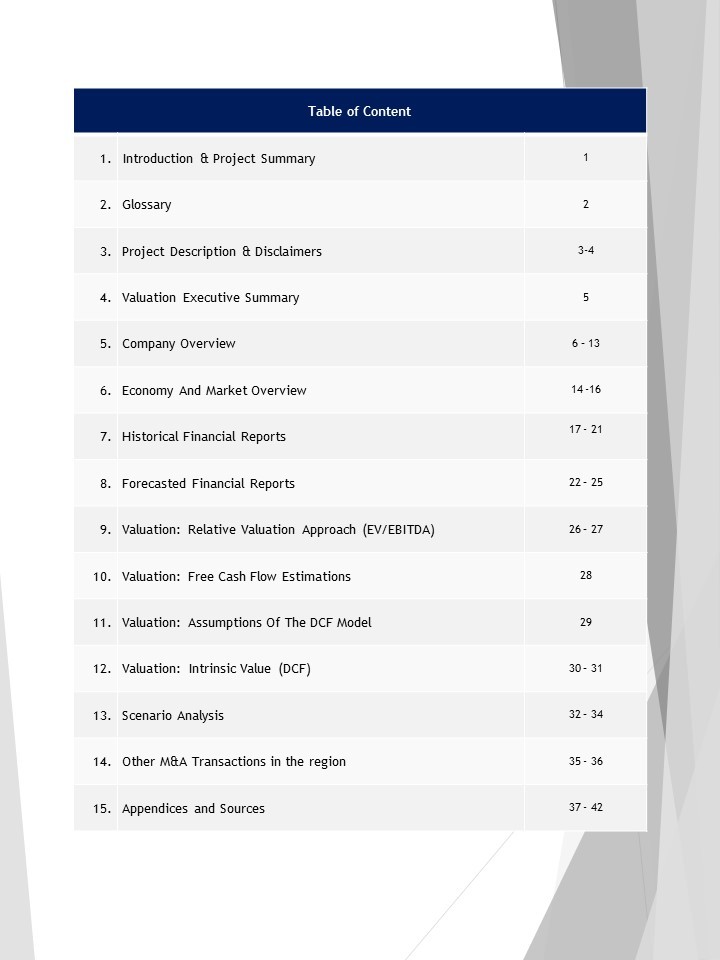The objective of performing a business valuation is to reach the intrinsic value of the business. The Intrinsic value is the fair value of the business. To do so, reach the intrinsic value, a comprehensive analysis of the business should be done by independent financial analysts, experienced and capable thats Why Valuation and Valuation Report.
They will articulate the process, the assumptions, and the findings in the valuation report, highlighted by the value or a range of values that they consider the fair value/s. But there are much more insights into the valuation report about business health, arguably, are more significant for investors and financiers than the money value. It gives them the reasons whether to pay the money value, negotiate or pass the investment.
The Valuation Report
It is a comprehensive report about business value, all the values! the process is the same regardless of the size of the business, but we will focus on small and medium-sized businesses (defined as with lower than 250 employees as per WB). Usually, It starts with the content, executive summary, the company historical financial reports for SMEs or the business plan for startups, then the financial data:
The reason for performing the valuation is the main influencer of the method and the kind of report generated. Fundamentally, It should include financial analysis of the historical data, forecasts of the future financials – item by item – and includes at least 3 scenarios, Base case, upper case, and lower case. The report should also include a discussion about the 3 approaches used to value the business:
Why Valuation and Valuation Report?
3 Approaches
- Asset-based approach
- Income-based approach and
- Market-based approach
Based on the nature of the business and the circumstances surrounding it, the evaluator can use one or multiple approaches to value the business. Sometimes, analysts use a weighted average value of the 3 approaches. Startups are exceptionally challenging for the simple reason that they do not have historic data, hence, the only available inputs for the financial model are the assumptions and the expected benefit.
The report is also the articulation of the financial model. It should be easy to read and understandable for non-financial readers. It includes an executive summary, an explanation of the approaches used, the logic behind it and a conclusion. The inputs of the financial model are the historical financial data and the assumptions of the micro and macroeconomics. The outcomes of the model are a detailed analysis of the main and secondary drivers of value for the business. All that data are presented in an understandable simple language report.
3 types of valuations exist in corporate finance: the first is known as the Pre-Money valuation, which is clear from its name, the value before an investment. The second is Post-Money valuation, meaning valuing a business before and after injecting the investment. Third, is the Sell/Buy-Side reports, are professional reports done by an internal evaluator for the buy-side or an external evaluator for the sell-side.
The Financial Model
The model is as good as its inputs. That’s why it is very important to exhibit the highest level of care, prudence and diligence by the analyst building the financial model in collecting the data and analysing it. It is an excel sheet focused. The model predicts earnings, costs and cash flows under different scenarios. The valuation model provides a detailed analysis of the earnings, costs, and benefits. It performs a financial “anatomy” of the business and provides the reader with insights about the working capital cycle the profitability and other key financial indicators.
Leverage buy out (LBO) and management buys out (MBO) are 2 types of financial models that used in specific circumstances such as financing the acquisition by debt issued by the company or internal buy out from the company management. Most commonly used, are the traditional equity valuation models.
Reasons
The intrinsic value of the business or its monetary value has been the most obvious reason for a valuation. During the normal course of the business, the owners could need to know the money value of the business for different motives i.e. partnership (new or exit), sell-off, inheritance issues…
To venture capital investors, the main reason to value a business is to capture the value in investing in the proposed project, the costs affiliated and the return expected. And, in a wider angle, evaluate whether the investment serves the objectives of the total portfolio.
For many investors, the main reason for valuation is to measure the value of their holdings in a portfolio company – not publicly listed –. Moreover, the valuation report is a key resource to validate the direction and the path to the exit. The report highlights gaps and pitfalls as well as opportunities and strengths that impact the future value of the business. The outcome detailed indicators and financial data provide a scan of the business at a specific point of time. It also provides highlights on the probable reasons for the lower case scenario and the limitations of the assumptions for the upper case scenario.
Visualizing the situation
Imagine that you have invested in a company. 2 to 3 years down the line it will be very difficult the assess the profitability of your investment or if it is profitable in the first place without a valuation. The ideal is to value the holding yearly to quickly fill the gaps and the drawbacks that could hurt the value in the future. Sometimes, companies own the model and just update it promptly.
The Valuator
Experience and intellect are basic requirements in the analyst. A particularly important aspect when choosing a valuator beside expertise and intellect is independence. Analysts are humans. They are influenced by the sources of information and they have biases that they should be always in control. The evaluator should maintain independence at all time, he should not accept, offer, solicit anything that jeopardies his independent status.
So there its, Why Valuation and Valuation Report?